Abstract
This study examines the relationship between impaired fatty acid oxidation and the pathogenesis of Reye syndrome. We present a hypothesis proposing that many clinical signs of this childhood disease are caused by accumulation of unusual acyl CoA esters, precursors to deacylated metabolites found in the patients' blood and urine. A new method was developed to measure acyl CoA compounds in small human liver biopsy samples, offering several advantages over previous techniques. A major finding was an accumulation in Reye syndrome patients of short- and medium-chain acyl CoA intermediates of fatty acid and branched-chain amino acid oxidation. These metabolites included octanoyl, isovaleryl, butyryl, isobutyryl, propionyl, and methylmalonyl CoA esters. The findings were explained in a model of hepatic fatty acid oxidation involving three interrelated pathways: mitochondrial beta-oxidation, peroxisomal beta-oxidation, and omega-oxidation in the endoplasmic reticulum. The results suggest that pathogenesis in Reye syndrome stems from generalized mitochondrial damage resulting in accumulation of acyl CoA esters. High levels of these compounds lead to inhibition of mitochondrial pathways for ureogenesis, gluconeogenesis, and fatty acid oxidation. The inhibited pathways, in turn, could cause the hyperammonemia, hypoglycemia, and hypoketonemia observed in patients. The model also explains underlying biochemical differences between patients with Reye syndrome and medium-chain acyl CoA dehydrogenase deficiency, another disorder of fatty acid metabolism. Acetyl CoA levels, in the latter disease, were dramatically decreased, compared with both human controls and Reye syndrome patients.
Full text
PDF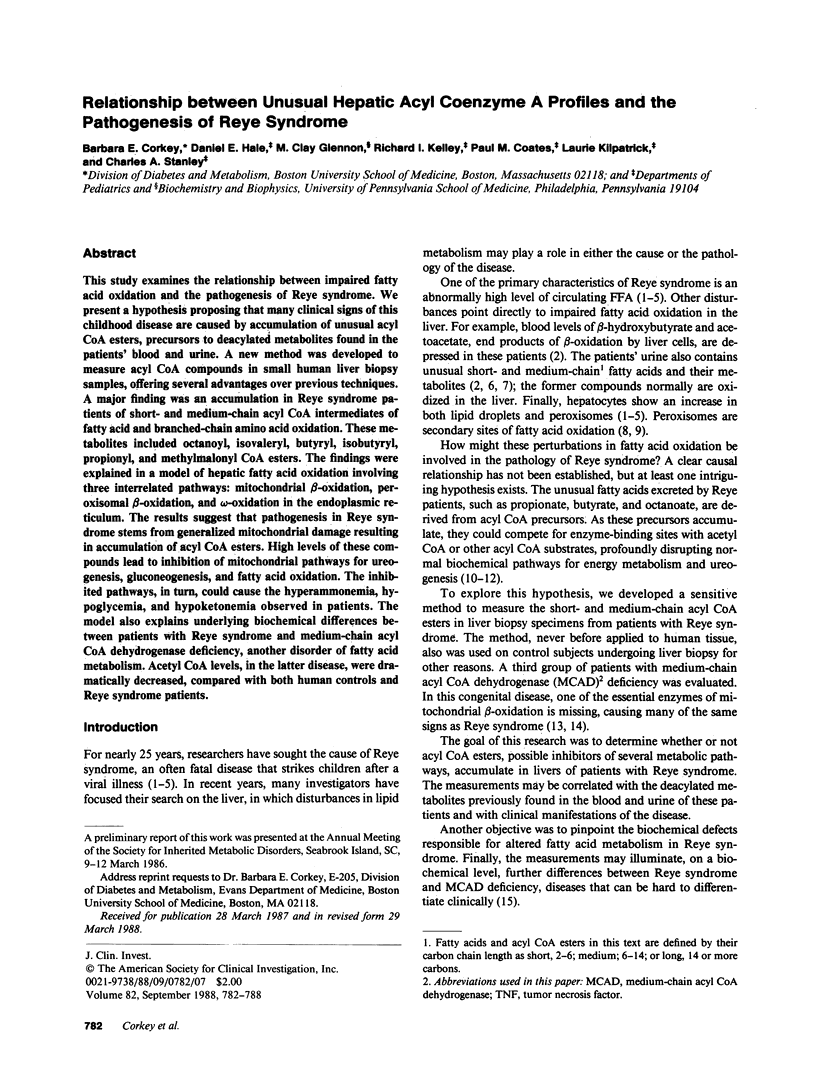
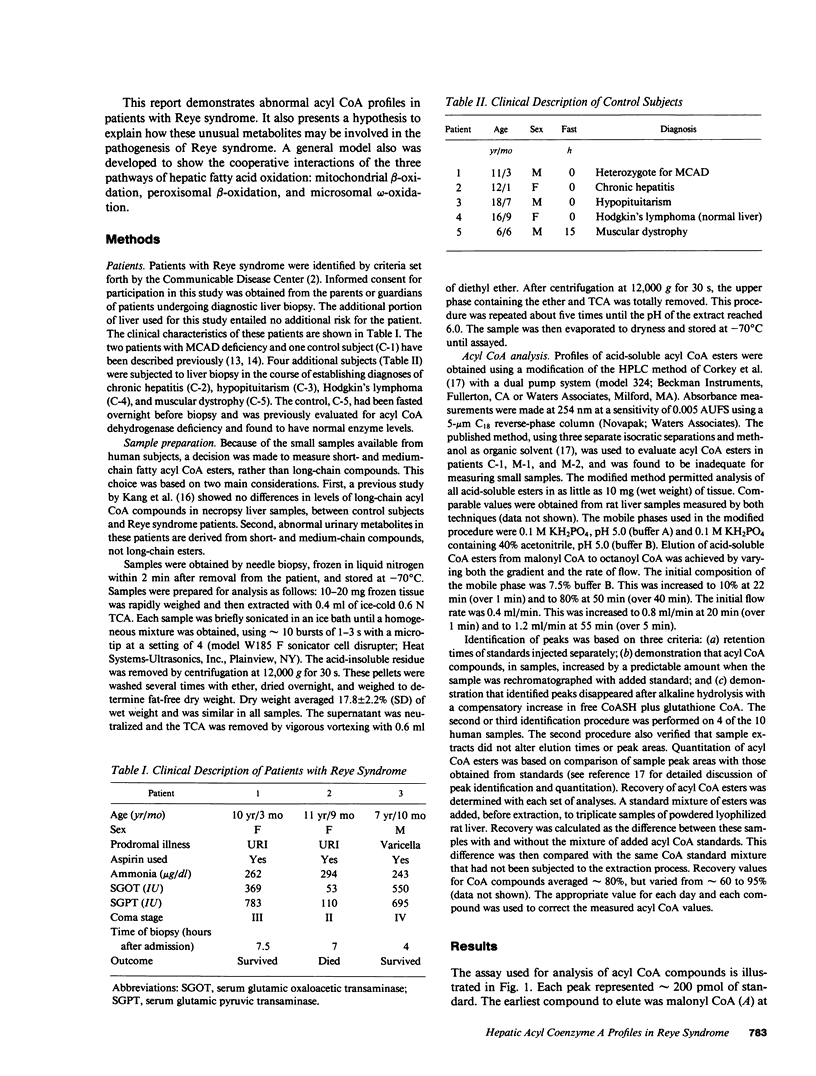
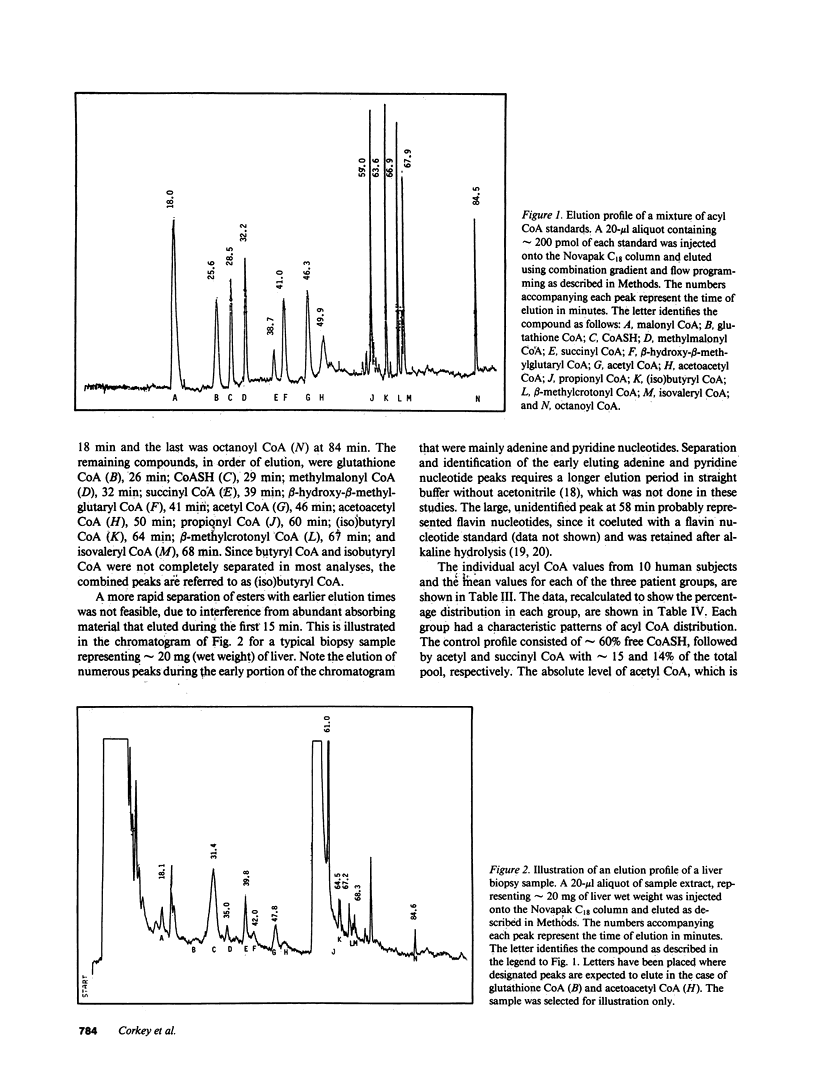
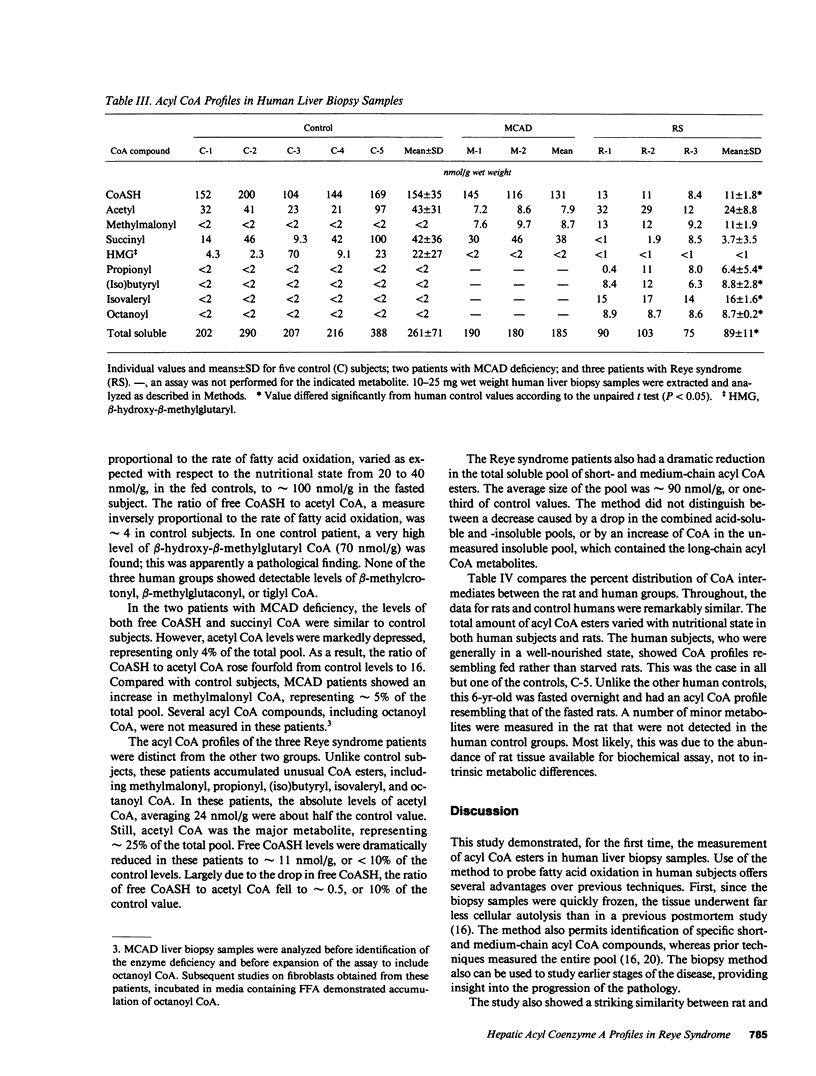
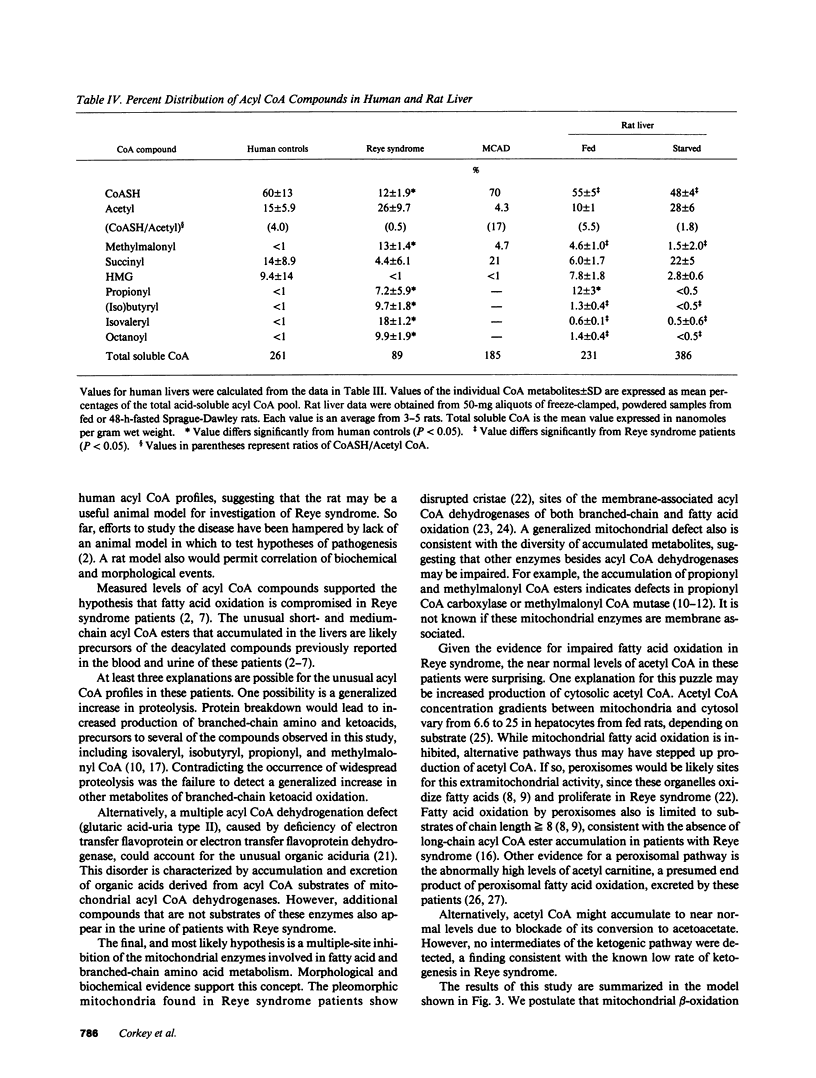
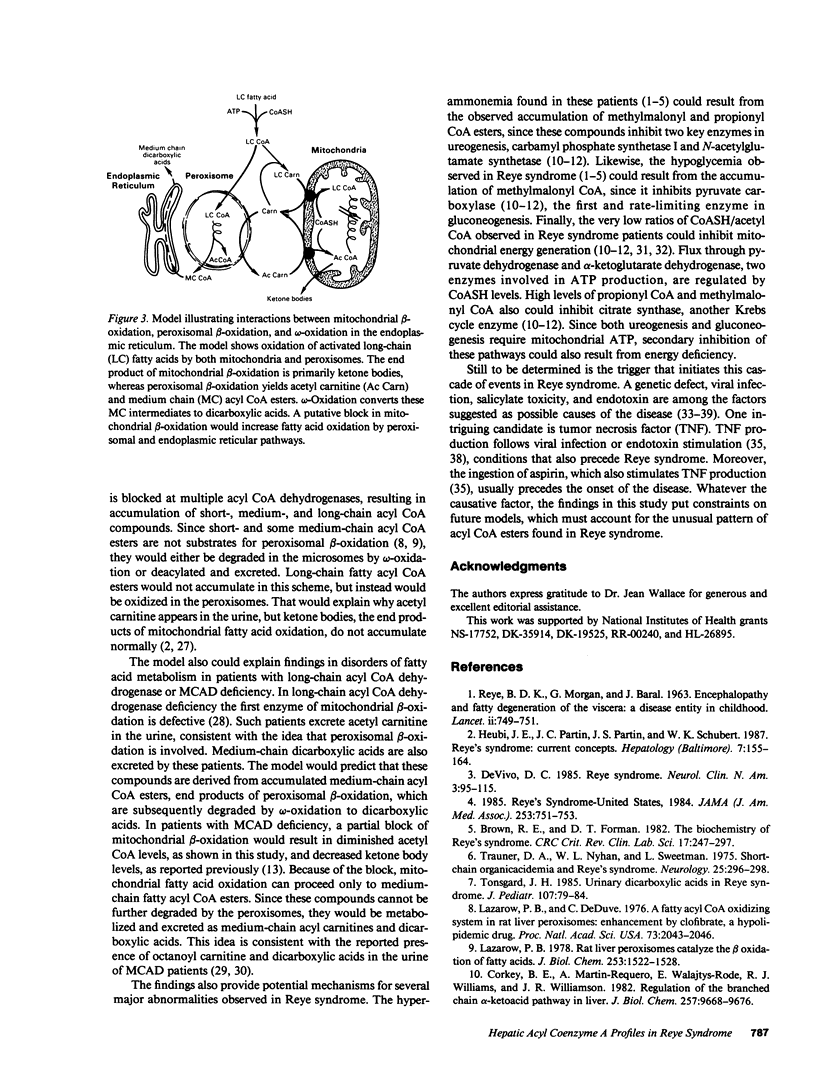
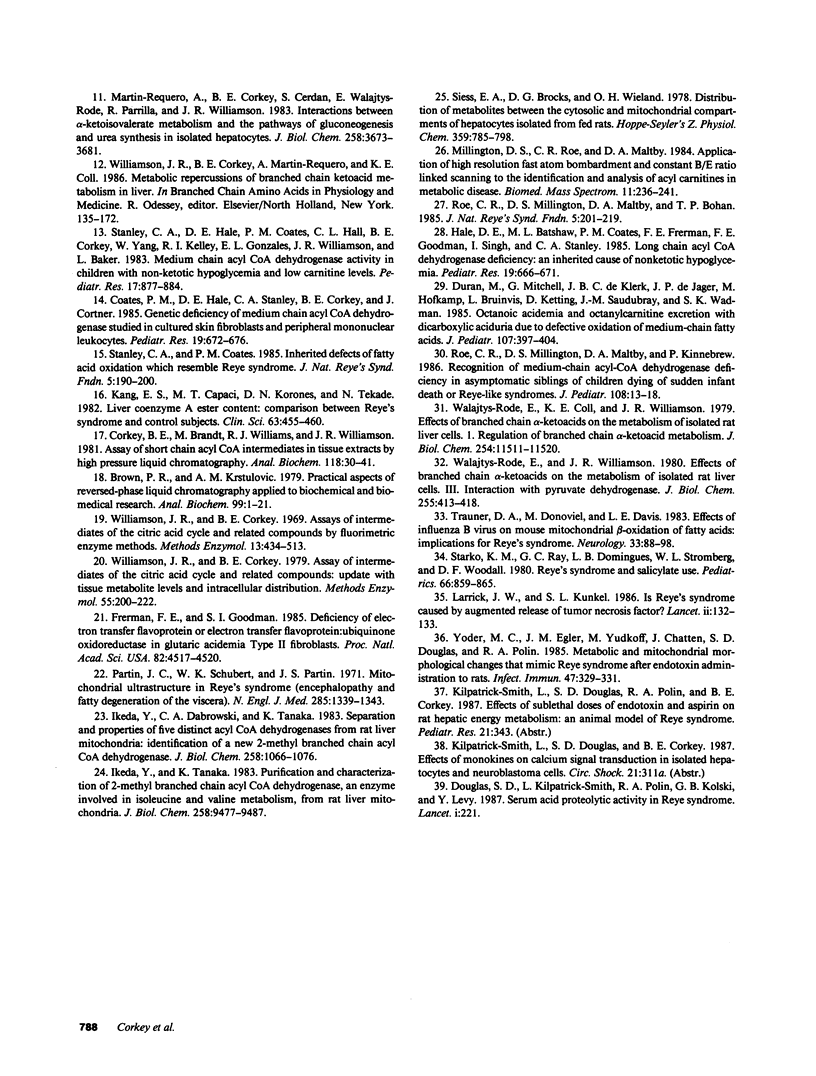
Selected References
These references are in PubMed. This may not be the complete list of references from this article.
- Brown P. R., Krstulovic A. M. Practical aspects of reversed-phase liquid chromatography applied to biochemical and biomedical research. Anal Biochem. 1979 Oct 15;99(1):1–21. doi: 10.1016/0003-2697(79)90038-1. [DOI] [PubMed] [Google Scholar]
- Brown R. E., Forman D. T. The biochemistry of Reye's syndrome. Crit Rev Clin Lab Sci. 1982;17(3):247–297. doi: 10.3109/10408368209107038. [DOI] [PubMed] [Google Scholar]
- Coates P. M., Hale D. E., Stanley C. A., Corkey B. E., Cortner J. A. Genetic deficiency of medium-chain acyl coenzyme A dehydrogenase: studies in cultured skin fibroblasts and peripheral mononuclear leukocytes. Pediatr Res. 1985 Jul;19(7):671–676. doi: 10.1203/00006450-198507000-00007. [DOI] [PubMed] [Google Scholar]
- Corkey B. E., Brandt M., Williams R. J., Williamson J. R. Assay of short-chain acyl coenzyme A intermediates in tissue extracts by high-pressure liquid chromatography. Anal Biochem. 1981 Nov 15;118(1):30–41. doi: 10.1016/0003-2697(81)90152-4. [DOI] [PubMed] [Google Scholar]
- Corkey B. E., Martin-Requero A., Walajtys-Rode E., Williams R. J., Williamson J. R. Regulation of the branched chain alpha-ketoacid pathway in liver. J Biol Chem. 1982 Aug 25;257(16):9668–9676. [PubMed] [Google Scholar]
- Douglas S. D., Kilpatrick-Smith L., Polin R. A., Kolski G. B., Levy Y. Serum acid proteolytic activity in Reye syndrome. Lancet. 1987 Jan 24;1(8526):221–221. doi: 10.1016/s0140-6736(87)90040-7. [DOI] [PubMed] [Google Scholar]
- Duran M., Mitchell G., de Klerk J. B., de Jager J. P., Hofkamp M., Bruinvis L., Ketting D., Saudubray J. M., Wadman S. K. Octanoic acidemia and octanoylcarnitine excretion with dicarboxylic aciduria due to defective oxidation of medium-chain fatty acids. J Pediatr. 1985 Sep;107(3):397–404. doi: 10.1016/s0022-3476(85)80514-x. [DOI] [PubMed] [Google Scholar]
- Frerman F. E., Goodman S. I. Deficiency of electron transfer flavoprotein or electron transfer flavoprotein:ubiquinone oxidoreductase in glutaric acidemia type II fibroblasts. Proc Natl Acad Sci U S A. 1985 Jul;82(13):4517–4520. doi: 10.1073/pnas.82.13.4517. [DOI] [PMC free article] [PubMed] [Google Scholar]
- Hale D. E., Batshaw M. L., Coates P. M., Frerman F. E., Goodman S. I., Singh I., Stanley C. A. Long-chain acyl coenzyme A dehydrogenase deficiency: an inherited cause of nonketotic hypoglycemia. Pediatr Res. 1985 Jul;19(7):666–671. doi: 10.1203/00006450-198507000-00006. [DOI] [PubMed] [Google Scholar]
- Heubi J. E., Partin J. C., Partin J. S., Schubert W. K. Reye's syndrome: current concepts. Hepatology. 1987 Jan-Feb;7(1):155–164. doi: 10.1002/hep.1840070130. [DOI] [PubMed] [Google Scholar]
- Ikeda Y., Dabrowski C., Tanaka K. Separation and properties of five distinct acyl-CoA dehydrogenases from rat liver mitochondria. Identification of a new 2-methyl branched chain acyl-CoA dehydrogenase. J Biol Chem. 1983 Jan 25;258(2):1066–1076. [PubMed] [Google Scholar]
- Ikeda Y., Tanaka K. Purification and characterization of 2-methyl-branched chain acyl coenzyme A dehydrogenase, an enzyme involved in the isoleucine and valine metabolism, from rat liver mitochondria. J Biol Chem. 1983 Aug 10;258(15):9477–9487. [PubMed] [Google Scholar]
- Kang E. S., Capaci M. T., Korones D. N., Tekade N. Liver coenzyme A ester content: comparison between Reye's syndrome and control subjects. Clin Sci (Lond) 1982 Nov;63(5):455–460. doi: 10.1042/cs0630455. [DOI] [PubMed] [Google Scholar]
- Larrick J. W., Kunkel S. L. Is Reye's syndrome caused by augmented release of tumour necrosis factor? Lancet. 1986 Jul 19;2(8499):132–133. doi: 10.1016/s0140-6736(86)91947-1. [DOI] [PubMed] [Google Scholar]
- Lazarow P. B., De Duve C. A fatty acyl-CoA oxidizing system in rat liver peroxisomes; enhancement by clofibrate, a hypolipidemic drug. Proc Natl Acad Sci U S A. 1976 Jun;73(6):2043–2046. doi: 10.1073/pnas.73.6.2043. [DOI] [PMC free article] [PubMed] [Google Scholar]
- Lazarow P. B. Rat liver peroxisomes catalyze the beta oxidation of fatty acids. J Biol Chem. 1978 Mar 10;253(5):1522–1528. [PubMed] [Google Scholar]
- Martin-Requero A., Corkey B. E., Cerdan S., Walajtys-Rode E., Parrilla R. L., Williamson J. R. Interactions between alpha-ketoisovalerate metabolism and the pathways of gluconeogenesis and urea synthesis in isolated hepatocytes. J Biol Chem. 1983 Mar 25;258(6):3673–3681. [PubMed] [Google Scholar]
- Millington D. S., Roe C. R., Maltby D. A. Application of high resolution fast atom bombardment and constant B/E ratio linked scanning to the identification and analysis of acylcarnitines in metabolic disease. Biomed Mass Spectrom. 1984 May;11(5):236–241. doi: 10.1002/bms.1200110508. [DOI] [PubMed] [Google Scholar]
- Partin J. C., Schubert W. K., Partin J. S. Mitochondrial ultrastructure in Reye's syndrome (encephalopathy and fatty degeneration of the viscera). N Engl J Med. 1971 Dec 9;285(24):1339–1343. doi: 10.1056/NEJM197112092852402. [DOI] [PubMed] [Google Scholar]
- REYE R. D., MORGAN G., BARAL J. ENCEPHALOPATHY AND FATTY DEGENERATION OF THE VISCERA. A DISEASE ENTITY IN CHILDHOOD. Lancet. 1963 Oct 12;2(7311):749–752. doi: 10.1016/s0140-6736(63)90554-3. [DOI] [PubMed] [Google Scholar]
- Roe C. R., Millington D. S., Maltby D. A., Kinnebrew P. Recognition of medium-chain acyl-CoA dehydrogenase deficiency in asymptomatic siblings of children dying of sudden infant death or Reye-like syndromes. J Pediatr. 1986 Jan;108(1):13–18. doi: 10.1016/s0022-3476(86)80762-4. [DOI] [PubMed] [Google Scholar]
- Siess E. A., Brocks D. G., Wieland O. H. Distribution of metabolites between the cytosolic and mitochondrial compartments of hepatocytes isolated from fed rats. Hoppe Seylers Z Physiol Chem. 1978 Jul;359(7):785–798. doi: 10.1515/bchm2.1978.359.2.785. [DOI] [PubMed] [Google Scholar]
- Stanley C. A., Hale D. E., Coates P. M., Hall C. L., Corkey B. E., Yang W., Kelley R. I., Gonzales E. L., Williamson J. R., Baker L. Medium-chain acyl-CoA dehydrogenase deficiency in children with non-ketotic hypoglycemia and low carnitine levels. Pediatr Res. 1983 Nov;17(11):877–884. doi: 10.1203/00006450-198311000-00008. [DOI] [PubMed] [Google Scholar]
- Starko K. M., Ray C. G., Dominguez L. B., Stromberg W. L., Woodall D. F. Reye's syndrome and salicylate use. Pediatrics. 1980 Dec;66(6):859–864. [PubMed] [Google Scholar]
- Tonsgard J. H. Urinary dicarboxylic acids in Reye syndrome. J Pediatr. 1985 Jul;107(1):79–84. doi: 10.1016/s0022-3476(85)80619-3. [DOI] [PubMed] [Google Scholar]
- Trauner D. A., Nyhan W. L., Sweetman L. Short-chain organic acidemia and Reye's syndrome. Neurology. 1975 Mar;25(3):296–298. doi: 10.1212/wnl.25.3.296. [DOI] [PubMed] [Google Scholar]
- Tyler K. L., McHenry L. C., Jr Classics in neurology. Fragments of neurologic history: pseudohypertrophic muscular dystrophy and Gowers' sign. Neurology. 1983 Jan;33(1):88–89. doi: 10.1212/wnl.33.1.88. [DOI] [PubMed] [Google Scholar]
- Walajtys-Rode E., Williamson J. R. Effects of branched chain alpha-ketoacids on the metabolism of isolated rat liver cells. III. Interactions with pyruvate dehydrogenase. J Biol Chem. 1980 Jan 25;255(2):413–418. [PubMed] [Google Scholar]
- Williamson J. R., Corkey B. E. Assay of citric acid cycle intermediates and related compounds--update with tissue metabolite levels and intracellular distribution. Methods Enzymol. 1979;55:200–222. doi: 10.1016/0076-6879(79)55025-3. [DOI] [PubMed] [Google Scholar]
- Williamson J. R., Wałajtys-Rode E., Coll K. E. Effects of branched chain alpha-ketoacids on the metabolism of isolated rat liver cells. I. Regulation of branched chain alpha-ketoacid metabolism. J Biol Chem. 1979 Nov 25;254(22):11511–11520. [PubMed] [Google Scholar]
- Yoder M. C., Egler J. M., Yudkoff M., Chatten J., Douglas S. D., Polin R. A. Metabolic and mitochondrial morphological changes that mimic Reye syndrome after endotoxin administration to rats. Infect Immun. 1985 Jan;47(1):329–331. doi: 10.1128/iai.47.1.329-331.1985. [DOI] [PMC free article] [PubMed] [Google Scholar]


